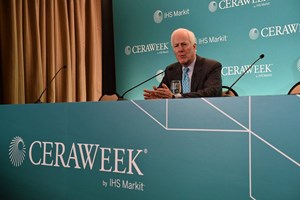Texas, Alaska viewpoints stress growth and innovation at final day of CERAWeek
Common themes of bountiful resources and expanding oil and gas production were sounded by a Texas senator and the Alaskan governor on the final day, Friday March 15, of the five-day CERAWeek conference in Houston. Sen. John Cornyn (Rep. – Texas) and Gov. Mike Dunleavy (Rep. – Alaska) expressed similar sentiments that their respective states can expand output and boost their economies while doing it in an environmentally sustainable manner that includes reducing emissions.
During his mid-morning conversation with CERA (Cambridge Energy Research Associates) founder Daniel Yergin, Cornyn said, “I keep wondering how much longer the Permian basin can continue to produce so much energy, but the energy companies that continue to operate there continue to be so innovative, and increasingly efficient. Even with relatively low oil prices, they’re still able to make a profit, and that’s a good thing. And, as a result of lifting the export ban on petroleum a couple of years ago, we’re able to sell that oil across the globe. To me, it’s not just a matter of jobs at home, it’s a matter of geopolitics, because we’ve seen where Mr. Putin wants to be the sole supplier of energy to Europe. I think it’s better for our friends and allies to have other choices. So, Texas continues to be an innovator, where people have gotten more and more efficient, and much more effective. It’s been not only a blessing for us here, but also for the country, and I would argue for the world.”
Asked by Yergin what the biggest political threat is to the current energy renaissance, Cornyn replied, “It’s government. It really is---it is this attitude that somehow, all of our nation’s problems can be solved in Washington D.C. It’s just not true….”
At one point in the conversation, Yergin asked Cornyn what he thought of the “Green New Deal” being pushed by the extreme left portion of the Democratic Party. Feigning surprise, Cornyn replied, “I’m shocked that you would raise that.” But turning more serious, Cornyn replied, “I think it shows that we have a lot of work to do. Obviously, there’s been a lot of concerns raised in the political class about climate change, and some people think that this is the single-most urgent issue for us to address. I can think of more urgent issues, like nuclear weapons, but having said that, we’re all concerned about the environment. The real question is how do you deal with the concerns about the environment, and we’ve seen the debate over coal in our energy mix. In Texas, we are truly an all-of-the-above state, and we generate the most electricity from renewable sources of any state. We’re not just an oil-and-gas state, although we do that a lot, and we do it well, and thank goodness for that.
“But I think, he continued, “it’s more a question of, are we going to turn over control of the economy to Washington, to the political class, in a sort of command-and-control form, or are we going to rely on what has brought us to today, which is a country of innovators, and a sector of the economy that’s not just about energy. I’m struck every time that I come to CERAWeek, that this is like a technology conference, as much as it is an energy conference. So, I think there’s a lot of exciting things being done to curb emissions.” Asked how he would vote on the Green New Deal when it comes up for a vote in the Senate, Cornyn joked, “I’m still thinking about that……but no, I’m going to have to vote against that. In some ways, it’s a proposed solution in search of a problem.”
Commenting on the new batch of young, ultra-left legislators in Congress, Cornyn observed, “As Winston Churchill once said, ‘the problem with humankind is that we are unteachable.’ And we forget the lessons that previous generations may have learned, whether it’s about the evils of socialism or some of the experiences that we’ve had that we should have learned from, but have to be reminded about or re-live those same lessons.
For his part, Dunleavy said that he believes Alaska is on the verge of an oil and gas production “renaissance.” “It started several years ago,” observed Dunleavy. “We were fortunate to have several corporations up in Alaska, like ExxonMobil, BP, Eni and ConocoPhillips. We also have had some smaller operators, like Bill Armstrong, who has had some vision in exploration. So, there is a renaissance up there, and there’s still millions of barrels of oil still yet to be produced.”
On the subject of shale, Dunleavy said that Alaska “has some potential for shale oil, and there’s lots of (sites that would be prospective), but right now, the focus is mostly on conventional plays” that operators already are developing. He also mentioned that the state is still looking for ways to monetize the vast amounts of natural gas that are currently stranded.
Asked by Yergin what the minimum level of throughput is, that’s required to operate the Trans-Alaska Pipeline economically, Dunleavy said, “Some have said 250,000 bopd, although the pipeline is designed to carry 2 MMbopd. So, it’s important to fill it right now, and there’s some technological work that’s continually being done, to make sure that the oil flows. But with the new oil that we’re anticipating, where we’re expecting to put online 200,000 to 300,000 bopd for the next several years, that will certainly add to the longevity of the pipeline.”



